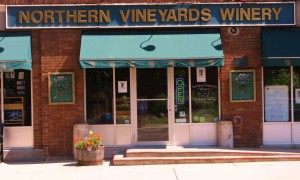Winning Over the Weather
Yes, I am guilty of it, as are many Minnesotans. Spring in this state is elusive, not guaranteed. As I drive during May 2011 from Minneapolis into the St. Croix River Valley, which forms our eastern border with Wisconsin, I am not thrilled by our swirling gray clouds, wind and rain and often sparse greenery that normally would be standing proudly forth in field and vineyard.
Half of the state’s vital corn and soybean crops are weeks late in getting planted, so this is not just an aesthetic concern. Two weeks before my trip, we still had snow even inside the metropolitan heat envelope–a month ago, we still had subzero temperatures which can be the death knell for European wine grapes, the fatal freezing of their fragile flowers and buds, who would be foolish enough to believe good wines could be grown here?
Yet it can be done, as my visit to St. Croix Vineyards and Winery proves. Lying on a long slope just west of the town of Stillwater, 25 miles east of Minneapolis, St. Croix is a rural remainder of what was once an area of small farms when the winery opened in 1992. Now they are surrounded on two sides by suburban golf courses, encroaching housing developments and what is left of the classic Aamodt’s Apple Orchards, which still grows but can’t afford to sell any of their produce to make hard cider as the tourist crowds demand those apples!
I am met in the tasting room with General Manager Matthew Scott as they open for the day. Boxes of garden ornaments are piled to be available to visitors who might be unsure about buying wine. ‘We have to diversify,” says Scott.
He talks about his background in mollusk research at the University of Minnesota (U of M) and his training with a California wine maker earlier in his career. In 2002, Scott worked for Chateau St. Croix in St. Croix Falls, Wisconsin. In 2005, he came back to Minnesota to his present job.
Scott explains how the terrains and microclimates of St. Croix’s three Minnesota vineyards vary hugely. The vineyard in Redwing along the Mississippi River is flat and loamy warm farm land. The Taylor’s Falls vineyard 75 miles north of Red Wing is pocked with gravel and granite boulders.
Scott’s winery and vineyards in Stillwater is in the latter zone, north of the 45th parallel in the center of the continent where temperatures can drop to -25 to -35. ‘I can’t do the La Crescent (a U of M hybrid grape) in Taylor’s Falls. Too cold.” However, the LaCrescent made with the Stillwater grapes has more of a tangerine aroma, while the Red Wing grapes produce more of a lime fruit bouquet on this varietal. (They won Silver in a competition last year in San Francisco with the Red Wing grown LaCrescent.)
They are trying to buy added land for planting, but aside from one neighboring farm, everything nearby has been built on. Still, they are able to produce 6,000 cases per year of more than a dozen wines all chosen for this inhospitable climate, which makes them the second biggest in Minnesota.
‘We have four acres here in Stillwater, but we source from a lot of other places,” he notes. When the winery was getting started, they had some Chardonnay, but such fragile varietals must be taken down off the wires and buried for the winter–too much work and still chancy.
They replanted with local hybrids such as Marechal Foch (‘maybe some of the oldest in the state”) and St. Pepin, which can make a fine eiswein but not dependably given the local weather. But St. Croix keeps experimenting: Marquette, a newer red grape developed by the U of M, makes what Scott says is his ‘favorite here finished with French oak.” They exchange technical ideas with Witness Tree Winery in Oregon, which is trying out Marquette vines too (they have Pinot Noir ancestry).
In development is a French-style rose made by fermenting the pink grape Frontenac Gris on the skins. Done in a Gewurztraminer-style, this is their No. 1 seller. ‘We might even try for a champagne-type, though nobody has mastered it here yet,” Scott says. He thinks that the Minnesota wine industry is the same stage developmental as Washington State roughly 15 years ago.
Although Minnesota taste buds have historically gone toward sweet, St. Croix has wonderful dry reds too. A 2009 Frontenac has the balance of a good Bordeaux with adequate tannin and a deep garnet color against a rich fruit aroma.
Their winemaker, Martin Polognioli, is originally from Argentina. He used to go home in the winter but now stays in Minnesota all year. Polognioli uses chromatography to check the wines, incubating the reds in the barrel for malolactic fermentation, keeping sulfur dioxide to less than 35 ppm–a very careful search for the best from Minnesota to make a dozen award-winning wines.
Northern Vineyards Winery
Driving less than 10 minutes east from St. Croix brought me past a huge ‘big box” shopping mall and then down into the heart of lovely historic Stillwater, one of the oldest towns in Minnesota. In strong, visual contrast to pastoral St. Croix Vineyards, is the Northern Vineyards Winery which is a cooperative of 12 growers from a wide-ranging territory who bring their product to international award-winning winemaker Robin Partch. There isn’t a vine within a mile, but he says this may be one of the oldest wineries in Minnesota. ‘We opened two weeks before Alexis Bailly (the Hastings Minnesota winery farther south along the Mississippi that coined the motto ‘Where the Grapes Can Suffer’).
Partch started with inspiration from his French wife and in-laws, who had vineyards in Burgundy. ‘[It] got me used to the idea of wine as part of daily life,” he says, ‘but as a teacher, I couldn’t afford to buy it, so I had to make it!” He made a rose from wild grapes in 1977 that won a Blue Ribbon at the state fair and never looked back.
Of course, at this time of year the main activity is bottling and Partch is deep into it. One of the interesting differences between his approach and some others is that he swears by newer, synthetic corks. ‘If they’re made by the right companies there is less danger of over oxidation or bacterial infection,” Partch says. ‘Synthetic corks still permit some exchange (of oxygen for bottle aging),” Partch adds. (Matthew Scott at St. Croix feels synthetics can over-oxidize wine and has gone back to fully organic corks.)
And his wines do work for aging–though we agree it is really fatuous to try to compare American French hybrids with French appellations–good wine always has its own particular gout de terroir. Northern Vineyard’s St. Croix Reserve is a 100 percent press-run St. Croix grapes and Partch says some people are still drinking a ten-year-old bottling. He recently filled a special order of St. Croix Reserve for a fancier in Santa Monica, Ca. Another top seller for the winery is the dry white ‘Columbine” made from 100 percent La Crosse, one of the older Elmer Swenson hybrids.
Partch admits taking some chances, allowing the pH to vary up from 3.5 a bit. ‘The French writers say you have to take the chance and the wine will be worth it,” he says.
A Votre Bon Sante!
(Scott Bartell worked in the food and wine industry in California (Robert Mondavi, Roudon-Smith, etc.) and was the first food and wine columnist for the City Pages in Minnesota)



